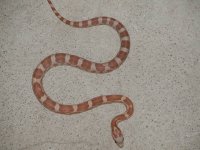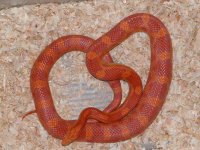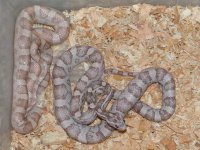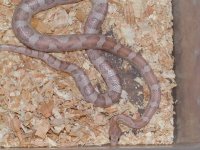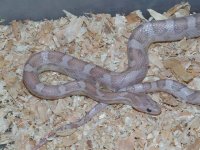ecreipeoj
Striped Topaz SK SG Free
Hi Cav,
Hi CAV,
How do you get pure wild-caught Okeetees from you CB "Trans line"?
Perhaps, I am stating it wrong. This snake is a descendent from the original 2.4 Okeetees that I bought. I was told they were F1’s from wild caught Okeetees which the Trans Hypo Okeetees came from. Considering that a previously unknown hypo gene was produced from these snakes, they appear to be Okeetee, but not the perfect Okeetee look we have selectively bred for in captivity, I feel they are most likely descendants from wild caught snakes. I have maintained that bloodline through inbreeding without introducing any new blood into it. I would have to check, but I think she is F2. I have F4’s from the same line. I refer to this line as the Transparent Hypo Okeetee Corn Snake line.
I started a different line from these snake by breeding a Trans Hypo Okeetee to an Albino that looked like an Albino Okeetee, which turned out to be het for snow. This line is the one which the “Blue Ice” came from. I refer to the hypos from this line as Trans Hypo Corns Snakes, without the Okeetee in the name or at least I try to be consistent that way. Some of the out crosses Hypos from this line look very close to the “Pure Trans Okeetees, especially the one’s which are 75% Okeetee. A Trans Hypo Okeetee X Trans Hypo yields 75% original blood line. From this line, I have produced Albinos, and Snows that have the “Okeetee” look. I have produced Anery as well, but they look pretty much like other anerys. I have produce one Anery male that was down right UGLY! when it was born, but I kept it since it was from this line. It is very hard to describe, but it just looks like a dirty brown color. It didn’t change much at a year, but now that it is an adult at three years of age you can tell why this snake looked so different as a baby. It has a tremendous about of pink on it like a pink snow. I guess the pink on it combined with the black made him look dirty brown. At a distance now, he still looks very odd, but up close he is very interesting looking. You can see the Anery underneath with the pink on top and in between the blotches. I produced a lavender this year that I labeled “What the H--! is this”. I think he is going to be the same way. He is not very old, but has a pink cast to his entire body. The photo (Attached) doesn’t show it, but it is there and I think it is making him look different. He is not ugly though. When he was born, he looked like a light chocolate hypo, but now I think it is just the pink on top of the lavender color.
I have out crossed the original Trans Hypo Okeetee line with the Sunkissed Okeetee this year and produced 13 normal looking hatchlings. I saved all of these, because they are from Kathy’s Okeetee line and combined with my line, I thought they would be very nice Okeetees. They are growing fast and have much wider and bolder black borders around their blotches like Kathy’s line. I also thought I needed new blood into the line and they are double het for two different hypo genes. I intend on breeding this line back to itself and trying to produce a Hypo Corns homozygous for Trans and Sunkissed hypo. I expect that I may not be able to tell the difference between a double homo and the other two types of hypos. I have not decided how to use these double het snakes to breed back into the original line. I am leaning toward not doing it and obtaining another Okeetee line with no hypo gene in it to out cross them to and keep the Trans Okeetee line pure. I am not actually hung up on Okeetee’s from wild caught stock. I just happen to have some. I think the “Okeetee” look is what I like and what I would purchase.
Hi CAV,
How do you get pure wild-caught Okeetees from you CB "Trans line"?
Perhaps, I am stating it wrong. This snake is a descendent from the original 2.4 Okeetees that I bought. I was told they were F1’s from wild caught Okeetees which the Trans Hypo Okeetees came from. Considering that a previously unknown hypo gene was produced from these snakes, they appear to be Okeetee, but not the perfect Okeetee look we have selectively bred for in captivity, I feel they are most likely descendants from wild caught snakes. I have maintained that bloodline through inbreeding without introducing any new blood into it. I would have to check, but I think she is F2. I have F4’s from the same line. I refer to this line as the Transparent Hypo Okeetee Corn Snake line.
I started a different line from these snake by breeding a Trans Hypo Okeetee to an Albino that looked like an Albino Okeetee, which turned out to be het for snow. This line is the one which the “Blue Ice” came from. I refer to the hypos from this line as Trans Hypo Corns Snakes, without the Okeetee in the name or at least I try to be consistent that way. Some of the out crosses Hypos from this line look very close to the “Pure Trans Okeetees, especially the one’s which are 75% Okeetee. A Trans Hypo Okeetee X Trans Hypo yields 75% original blood line. From this line, I have produced Albinos, and Snows that have the “Okeetee” look. I have produced Anery as well, but they look pretty much like other anerys. I have produce one Anery male that was down right UGLY! when it was born, but I kept it since it was from this line. It is very hard to describe, but it just looks like a dirty brown color. It didn’t change much at a year, but now that it is an adult at three years of age you can tell why this snake looked so different as a baby. It has a tremendous about of pink on it like a pink snow. I guess the pink on it combined with the black made him look dirty brown. At a distance now, he still looks very odd, but up close he is very interesting looking. You can see the Anery underneath with the pink on top and in between the blotches. I produced a lavender this year that I labeled “What the H--! is this”. I think he is going to be the same way. He is not very old, but has a pink cast to his entire body. The photo (Attached) doesn’t show it, but it is there and I think it is making him look different. He is not ugly though. When he was born, he looked like a light chocolate hypo, but now I think it is just the pink on top of the lavender color.
I have out crossed the original Trans Hypo Okeetee line with the Sunkissed Okeetee this year and produced 13 normal looking hatchlings. I saved all of these, because they are from Kathy’s Okeetee line and combined with my line, I thought they would be very nice Okeetees. They are growing fast and have much wider and bolder black borders around their blotches like Kathy’s line. I also thought I needed new blood into the line and they are double het for two different hypo genes. I intend on breeding this line back to itself and trying to produce a Hypo Corns homozygous for Trans and Sunkissed hypo. I expect that I may not be able to tell the difference between a double homo and the other two types of hypos. I have not decided how to use these double het snakes to breed back into the original line. I am leaning toward not doing it and obtaining another Okeetee line with no hypo gene in it to out cross them to and keep the Trans Okeetee line pure. I am not actually hung up on Okeetee’s from wild caught stock. I just happen to have some. I think the “Okeetee” look is what I like and what I would purchase.

